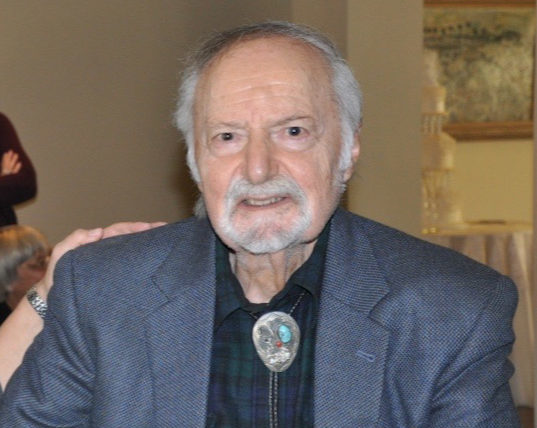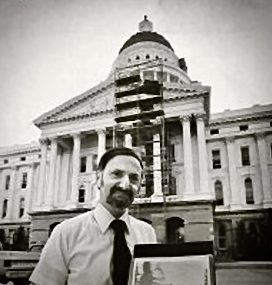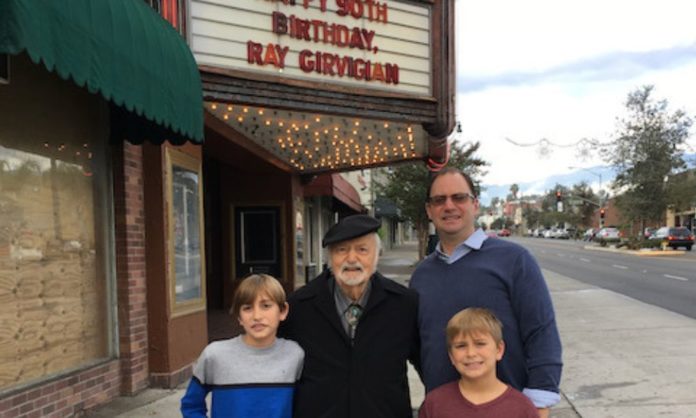By Michael R. Girvigian, M.D. and James Spencer, FAIA
Raymond Girvigian was born in 1926 in Detroit, Michigan. Ray was son of Manoug (Michael) and Margaret Girvigian. His parents were Armenian immigrants who came to America during the early 20th Century, seeking asylum from the Turkish persecution of Armenians just prior to WWI.
Margaret was able to come to the United States with most of her family, several of whom wound up in the Mid-West through several circuitous routes. Manoug was the oldest of 7 brothers. He came to the U.S. in the 1910’s to work and send money back to bring his family to this country. He was able to get his youngest brother out of Turkish occupied Armenia, Harry Girvigian.
Unfortunately, the rest of Manoug’s family, his brothers, parents, and extended family, perished during the Genocide in Turkish occupied Armenia. Manoug, like many immigrants at that time, settled in Detroit and went to work in the Auto factories. He worked hard and saved his money. Eventually, he opened his own barber shop, and later a small hotel and restaurant partnering with the Arslanian family, whom he knew from the old country.
The stock market crash of 1929 severely affected the family. The run on the banks during that period, led to unscrupulous actions by the banking system against their customers. Banking clients did not have the protections from the banking system that people enjoy today, especially immigrants who spoke broken English and came from a place that no one had ever heard of. Even though they were current with their payments, the bank foreclosed on the small Savoy Hotel in Detroit that Manoug and his partner, Hairabed Arslanian worked so hard to build. Manoug, the eternal optimist, packed up the family, and moved to California.
The family settled in Pico Rivera, California, where they eventually began operating a small “auto court”, and later a restaurant called the “Shangri La” on Whittier Blvd. Soon after, the still standing Clearman’s Family Restaurant opened across the street. Ray’s father managed the restaurant, and his mother, Margaret, the auto court.
There was a small house behind the restaurant, where the family lived. As Ray’s older cousin, Gini Colvig (Surabian) once said, Ray’s father was the only one who could keep the family fed through the depression, even if it was “mustard sandwiches”.
Ray attended Whittier Union High School. Ray showed an aptitude for Math and Physics in High School and loved to build models and draw. For a class project in the 9th grade, he was asked to write about what he wanted to be. His number one choice was “pilot”, WWII was all the news at that time, second was architect.
Ray graduated in 1943, at the age of 17 years old. He wanted to enlist in the Army, at the height of WWII. He needed a signed affidavit from his parents because he was under the age of 18. His parents reluctantly signed, and he was accepted in the Army specialized training program as a Cadet, for eventual assignment to the Combat Engineers.
In 1945, he was moved to the 4th Infantry Division, preparing for the invasion of Japan that summer. As Ray once said, Combat Engineers were highly expendable. They had to operate under fire, without returning fire. “I wouldn’t be here if Truman hadn’t dropped the bomb”, Ray would say.
Ray benefited from the G.I. Bill, under which he enrolled at UCLA, and ultimately the U.C. Berkeley School of Architecture, from which he graduated “with Highest Honors in Architecture”. He stayed on to obtain his Masters Degree in Architecture in 1951. He traveled the world for one year after he graduated, exploring the famous landmarks he had been studying for the previous six years.
Ray was fortunate to be offered a position at Pereira & Luckman in Los Angeles and was assigned to work on Cape Canaveral. He became disenchanted with the firm, “too much of a factory”. He resigned in favor of working for a smaller firm, Hutchason Architects, a father and son team. He worked on many projects with this firm, from schools to hospitals.
In 1957, Ray began his own practice. Initially, he designed dinner house restaurants, based on his experience growing up in the family business. He then transitioned to several civil works projects in the greater Los Angeles Area, small city halls and community facilities. It really wasn’t until the later, that he began to concentrate mainly in historic preservation.
With the Post War boom, the attitude in Southern California was “out with the old; in with the new.” Ray, remembering in his travels in other parts of the world, where culture is preserved through the art of the ancients, felt that this country was losing it’s culture. He believed that without preserving the past, the culture of a society is lost.
He developed his own view of “Urban Conservation.” And using the AIA Historic Buildings Committee as a springboard, Ray in 1959 proposed new laws to prevent the demolition of historic landmarks in LA.
Ray learned the importance of recruiting influential people to the cause, including architect Paul R. Williams, then president of the L. A. Art Commission.
It was time for preservation law to be written, and to identify the threatened landmarks. Ray wrote his first bill and adopted in 1962, it became the first comprehensive large US City preservation ordinance. It was put to work immediately. A stop notice on demolition was ordered for the Leonis Adobe of Calabasas. The Leonis, and multiple other historic buildings were saved from the wrecking ball.

Historic preservation rapidly came to dominate Ray’s personal and professional life in the 1960’s. At a fund raiser to save the Watts Towers from demolition, Ray met Beverly Bennett in 1965. Beverly was an artist and an interior designer. Beverly encouraged Ray in his public service activities. They certainly complemented each other. They married in 1967, and settled in South Pasadena. An opportunity came soon after marriage when Ray was nominated by the LA Chapter to the newly formed Historic American Buildings Survey Board in Washington DC. In 1970 they were blessed with a son, Michael who is now a radiation oncologist.
Also in 1970, Ray was nominated by the CCAIA and appointed by Governor Reagan as the first “Historical Architect” to the State Landmarks Committee (later the Historic Resources Commission). He served eight years on the Commission, reviewing California’s first nominations to the National Register. In 1972, Ray was nominated by the LA Chapter and advanced to the National AIA College of Fellows for his work in historic preservation.
Ray was one of the original 710 “freeway fighters”. Ray’s passion for historic preservation, were critical for this long-standing fight against the build of the 710 Freeway “Meridian route” through the city of South Pasadena. Ray’s involvement in state and national commissions, and his ability to get new preservation laws on the books, gave him the credibility to supply countless hours of crucial testimony and legal challenges.
Without his involvement in this battle, the city might be a very different place today.
 A career breakthrough came with a feasibility study to either retrofit the old 1872 State Capitol in Sacramento or abandon it for a new modern facility. In 1974, Ray was selected to produce the Historic Feasibility Study that helped make the final decision to restore and reuse the building rather than replace it. For that work, he was chosen as “Historic Architect” and Welton Becket Associates as “Executive Architect”.
A career breakthrough came with a feasibility study to either retrofit the old 1872 State Capitol in Sacramento or abandon it for a new modern facility. In 1974, Ray was selected to produce the Historic Feasibility Study that helped make the final decision to restore and reuse the building rather than replace it. For that work, he was chosen as “Historic Architect” and Welton Becket Associates as “Executive Architect”.
Ray became the Consultant to the State Senate to provide a master plan and historic research along with necessary design documents upon which to base the restoration. He proposed and was commissioned to develop the Capitol Museum and the Art and Antiquities projects that also included historic offices for the legislators housed in the old building.
This was a decade’s long project, that included a rediscovery of the “old ways”, technologies and craftsmanship that had been lost to the ravages of time. The project won Ray and the Beckett firm an AIA National Honor Award in 1983.
In the more than 30 years that followed, Ray continued his pro bono service as AIA State Preservation Coordinator, along with a very active restoration practice. Among those pro bono efforts are such milestone legislations as The Mills Act (SB 357 property taxation of historic properties), the 1979 State Historical Building Code, and the 1985 State Capitol Commission law. He co-authored all three and is the founding chairman emeritus of the latter two.
In the later 1990’s Beverly became ill. Ray devotedly took care of her for many years, giving up most all his professional activities to concentrate on his wife’s care. She unfortunately passed away in 2005.
Heartbroken, Ray needed to find a new direction to focus his attention and contain his grief. Ray had been a parishioner at St. James Church for many years. He became intimately involved with the Buildings and Grounds committee at St. James Church in South Pasadena, eventually becoming the recognized historian for the church. His insights were invaluable for Church. With a properly maintained facility, the Church could better carry out its mission. As much as his service to the Church was appreciated, Ray appreciated this more. This work gave him a new lease on life, when he thought he had lost his.
Ray was given the Lifetime Achievement Award by the AIA in 2011.
Asked what he would advise young architects to do in today’s economy, he offered the following:
- “Opportunities don’t just drop in your lap; you have to work to create them.”
- “Don’t be shy about standing up for your principles.”
- “Volunteer your time and then build on your contacts with influential organizations and individuals.”
- “Resist the temptation to spend when you are making it; develop a reserve for the slow times.”
Ray passed away peacefully June 7, 2022 surrounded by family. Services are planned at St. James Church in South Pasadena.















.png)







